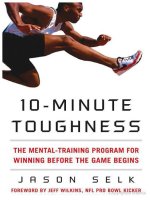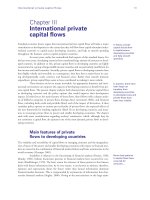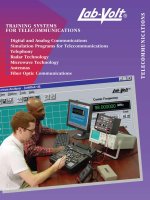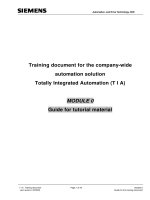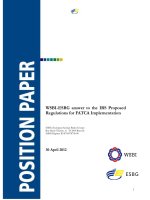TRAINING REGULATIONS FOR ILLUSTRATION NC II
Bạn đang xem bản rút gọn của tài liệu. Xem và tải ngay bản đầy đủ của tài liệu tại đây (418.24 KB, 57 trang )
<span class="text_page_counter">Trang 1</span><div class="page_container" data-page="1">
<b>ILLUSTRATION NC II </b>
<b> TECHNICAL EDUCATIONAND SKILLS DEVELOPMENT AUTHORITY</b>
<b>East Service Road, South Superhighway, Taguig City, Metro Manila </b>
</div><span class="text_page_counter">Trang 2</span><div class="page_container" data-page="2"><i>Technical Education and Skills Development Act of 1994 (Republic Act No. 7796) </i>
<b>Article I. Section 22, “Establishment and Administration of the National Trade Skills Standards” of the RA 7796 known as the TESDA Act mandates TESDA to establish national occupational skill standards. The Authority shall develop and implement a certification and accreditation program in which private industry group and trade associations are accredited to conduct approved trade tests, and the local government units to promote such trade testing activities in their respective areas in accordance with the guidelines to be set by the Authority.</b>
</div><span class="text_page_counter">Trang 3</span><div class="page_container" data-page="3">The Training Regulations (TR) serve as basis for the:
1. Competency assessment and certification;
2. Registration and delivery of training programs; and
3. Development of curriculum and assessment instruments. Each TR has four sections:
Section 1 Definition of Qualification - refers to the group of competencies that describes the different functions of the qualification.
Section 2 Competency Standards - gives the specifications of competencies required for effective work performance.
Section 3 Training Standards - contains information and requirements in designing training program for certain Qualification. It includes curriculum design, training delivery; trainee entry requirements; tools, equipment and materials; training facilities; trainer’s qualification; and institutional assessment.
Section 4 National Assessment and Certification Arrangements - describe the policies governing assessment and certification procedure
</div><span class="text_page_counter">Trang 4</span><div class="page_container" data-page="4"><b>TABLE OF CONTENTS ILLUSTRATION NC II </b>
Page No.
<b>SECTION 2 COMPETENCY STANDARD </b>
<b>3.4 List of Tools, Equipment and Materials 47 </b>
</div><span class="text_page_counter">Trang 5</span><div class="page_container" data-page="5"><b>TRAINING REGULATIONS FOR ILLUSTRATION NC II </b>
<b>SECTION 1 ILLUSTRATION NC II QUALIFICATION </b>
The ILLUSTRATION NC II Qualification consists of competencies that a person must achieve in enhancing writings by providing a visual representation that corresponds to the content of the associated text. The illustration may be intended to clarify complicated concepts or objects that are difficult to describe textually, or the illustration may be used to express emotion, or perception of things and ideas as in greeting cards, or cover art or interior art for books and magazines, or for advertisement, as on posters. The illustrator may specialize in a specific type and/or medium of drawings, e.g. realistic or cartoon drawings, using poster colors, pencil, etc. using traditional or digital or combination of digital and traditional methods
This Qualification is packaged from the competency map of the Visual Arts, Crafts and Design as shown in Annex A.
The units of competency comprising this Qualification include the following:
<b>CODE No. BASIC COMPETENCIES </b>
<b>CODE No. COMMON COMPETENCIES </b>
<b>CODE No. CORE COMPETENCIES </b>
A person who has achieved this Qualification is competent to be:
</div><span class="text_page_counter">Trang 6</span><div class="page_container" data-page="6"><b>TRAINING REGULATIONS FOR ILLUSTRATION NC II </b>
<b>SECTION 1 ILLUSTRATION NC II QUALIFICATION </b>
The ILLUSTRATION NC II Qualification consists of competencies that a person must achieve in enhancing writings by providing a visual representation that corresponds to the content of the associated text. The illustration may be intended to clarify complicated concepts or objects that are difficult to describe textually, or the illustration may be used to express emotion, or perception of things and ideas as in greeting cards, or cover art or interior art for books and magazines, or for advertisement, as on posters. The illustrator may specialize in a specific type and/or medium of drawings, e.g. realistic or cartoon drawings, using poster colors, pencil, etc. using traditional or digital or combination of digital and traditional methods
This Qualification is packaged from the competency map of the Visual Arts, Crafts and Design as shown in Annex A.
The units of competency comprising this Qualification include the following:
<b>CODE No. BASIC COMPETENCIES </b>
<b>CODE No. COMMON COMPETENCIES </b>
<b>CODE No. CORE COMPETENCIES </b>
A person who has achieved this Qualification is competent to be:
</div><span class="text_page_counter">Trang 7</span><div class="page_container" data-page="7">2.5 Follow-up or verbal instructions
5. Workplace
interactions <sup>5.1 </sup><sub>5.2 </sub> <sup>Face-to-face interactions </sup><sub>Telephone conversation </sub>
instruction and forms
and diagrams
</div><span class="text_page_counter">Trang 8</span><div class="page_container" data-page="8"><b>EVIDENCE GUIDE </b>
1. Critical aspects of competency
Assessment requires evidence that the candidate:
the organization
1.3 Made use of relevant terms as an aid to transfer information
2.6 Technology relevant to the enterprise and the individual’s work responsibilities
3.2 Perform routine workplace duties following simple written notices
3.6 Basic mathematical processes of addition, subtraction, division and multiplication
3.7 Ability to relate to people of social range in the workplace
</div><span class="text_page_counter">Trang 9</span><div class="page_container" data-page="9">UNIT OF COMPETENCY : <b>WORK IN A TEAM ENVIRONMENT </b>
identify role and responsibility as a member of a team.
<b>ELEMENT </b> <i><b><sub>Italicized terms are elaborated in the Range of Variables </sub></b></i><b><sup>PERFORMANCE CRITERIA </sup></b>
1. Describe team’s role and scope
1.1 <i><b>The role and objective of the team is identified from available sources of information </b></i>
1.2 Team parameters, reporting relationships and responsibilities are identified from team discussions and appropriate external sources
2. Identify own role and responsibility within the team
2.1 Individual role and responsibilities within the team environment are identified
2.2 Roles and responsibility of other team members are identified
interactions undertaken with team members who contribute to known team activities and objectives
team activities and objectives, based on individual skills and
<i><b>competencies and workplace context </b></i>
procedures
an understanding of team’s role and objectives and individual competencies of the members.
</div><span class="text_page_counter">Trang 10</span><div class="page_container" data-page="10"><b>EVIDENCE GUIDE </b>
1. Critical aspects of competency
Assessment requires evidence that the candidate:
the organization
1.3 Made use of relevant terms as an aid to transfer information
2.6 Technology relevant to the enterprise and the individual’s work responsibilities
3.2 Perform routine workplace duties following simple written notices
3.6 Basic mathematical processes of addition, subtraction, division and multiplication
3.7 Ability to relate to people of social range in the workplace
</div><span class="text_page_counter">Trang 11</span><div class="page_container" data-page="11"><b>EVIDENCE GUIDE </b>
1. Critical aspects of competency
Assessment requires evidence that the candidate:
1.2 Worked effectively with others
1.3 Conveyed information in written or oral form
workplace 4. Resource
environment where assessment can take place 4.2. Materials relevant to the proposed activity or tasks 5. Method of
assessment
Competency may be assessed through:
5.1 Observation of the individual member in relation to the work activities of the group
5.2 Observation of simulation and or role play involving the participation of individual member to the attainment of organizational goal
5.3 Case studies and scenarios as a basis for discussion of issues and strategies in teamwork
6. Context of
assessment <sup>6.1 </sup> <sup>Competency may be assessed in workplace or in a simulated </sup>workplace setting
undertaken whether individually or in group
</div><span class="text_page_counter">Trang 12</span><div class="page_container" data-page="12"><b>UNIT OF COMPETENCY : PRACTICE CAREER PROFESSIONALISM </b>
career growth and advancement.
<b>ELEMENT </b> <i><b><sub>Italicized terms are elaborated in the Range of Variables </sub></b></i><b><sup>PERFORMANCE CRITERIA </sup></b>
1. Integrate personal objectives with organizational goals
improving the qualifications set for the profession
1.2 Intra and interpersonal relationships is are maintained in the course of managing oneself based on performance
<i><b>evaluation </b></i>
in the performance of duties 2. Set and meet work
priorities
and organizational goals and objectives.
2.2 <i><b>Resources are utilized efficiently and effectively to manage </b></i>
work priorities and commitments
and facilities are followed as per established procedures 3. Maintain professional
growth and development
availed of based on job requirements
proof of career advancement
are obtained and renewed
</div><span class="text_page_counter">Trang 13</span><div class="page_container" data-page="13">3. Trainings and career
opportunities <sup>3.1 </sup> <sup>Participation in training programs </sup><sub>3.1.1 Technical </sub>
</div><span class="text_page_counter">Trang 14</span><div class="page_container" data-page="14"><b>EVIDENCE GUIDE </b>
1. Critical aspects of competency
Assessment requires evidence that the candidate:
1.2 Worked effectively with others
1.3 Conveyed information in written or oral form
workplace 4. Resource
environment where assessment can take place 4.2. Materials relevant to the proposed activity or tasks 5. Method of
assessment
Competency may be assessed through:
5.1 Observation of the individual member in relation to the work activities of the group
5.2 Observation of simulation and or role play involving the participation of individual member to the attainment of organizational goal
5.3 Case studies and scenarios as a basis for discussion of issues and strategies in teamwork
6. Context of
assessment <sup>6.1 </sup> <sup>Competency may be assessed in workplace or in a simulated </sup>workplace setting
undertaken whether individually or in group
</div><span class="text_page_counter">Trang 15</span><div class="page_container" data-page="15">UNIT OF COMPETENCY : <b>PRACTICE OCCUPATIONAL HEALTH AND SAFETY PROCEDURES </b>
regulatory and organizational requirements for occupational health and safety.
<b>ELEMENT </b> <i><b><sub>Italicized terms are elaborated in the Range of Variables </sub></b></i><b><sup>PERFORMANCE CRITERIA </sup></b>
1. Identify hazards and risks
practices and procedures are clarified and explained based on organization procedures
indicators are identified to minimize or eliminate risk to co-workers, workplace and environment in accordance with organization procedures
other emergencies are recognized and established in accordance with organization procedures
2. Evaluate hazards and
risks <sup>2.1 Terms of maximum tolerable limits which when exceeded will </sup>result in harm or damage are identified based on threshold limit values (TLV)
2.2 Effects of the hazards are determined
2.3 OHS issues and/or concerns and identified safety hazards are reported to designated personnel in accordance with workplace requirements and relevant workplace OHS legislation
3. Control hazards and
risks <sup>3.1 Occupational health and safety (OHS) procedures for </sup>controlling hazards/risks in workplace are consistently followed
3.2 Procedures for dealing with workplace accidents, fire and emergencies are followed in accordance with organization OHS policies
<i><b>3.3 Personal protective equipment (PPE) is correctly used in </b></i>
accordance with organization OHS procedures and practices 3.4 Appropriate assistance is provided in the event of a
workplace emergency in accordance with established organization protocol
4. Maintain OHS
awareness <i><b><sup>4.1 Emergency-related drills and trainings are participated in </sup></b></i>as per established organization guidelines and procedures
<i><b>4.2 OHS personal records are completed and updated in </b></i>
accordance with workplace requirements
</div><span class="text_page_counter">Trang 16</span><div class="page_container" data-page="16"><b>RANGE OF VARIABLES </b>
1. Safety regulations May include but are not limited to: 1.1 Clean air act
1.3 National electrical and fire safety codes
2.1 Physical hazards – impact, illumination, pressure, noise, vibration, temperature, radiation
2.2 Biological hazards- bacteria, viruses, plants, parasites, mites, molds, fungi, insects
gasses, vapors
Psychological factors – over exertion/ excessive force, awkward/static positions, fatigue, direct pressure, varying metabolic cycles
Physiological factors – monotony, personal relationship, work out cycle
</div><span class="text_page_counter">Trang 17</span><div class="page_container" data-page="17"><b>EVIDENCE GUIDE </b>
1. Critical aspects of competency
Assessment requires evidence that the candidate:
control practices and procedures
1.2 Identified hazards/risks in the workplace and its
corresponding indicators in accordance with company procedures
accidents, fire and other emergencies
1.4 Identified terms of maximum tolerable limits based on threshold limit value (TLV)
for controlling hazards/risks in workplace
with company OHS procedures and practices
accordance with workplace requirements 2. Underpinning
knowledge and attitude
2.4 Hazards/risks identification and control
2.7 Organization safety and health protocol
3.2 Hazards/risks identification and control skills 3.3 Interpersonal skills
4. Resource implications
<b>The following resources MUST be provided: </b>
</div><span class="text_page_counter">Trang 18</span><div class="page_container" data-page="18"><b>EVIDENCE GUIDE </b>
1. Critical aspects of
competency <sup>Assessment requires evidence that the candidate: </sup><sub>1.1 Attained job targets within key result areas (KRAs) </sub>
1.2 Maintained intra and interpersonal relationship in the course of managing oneself based on performance evaluation
1.3 Completed trainings and career opportunities which are based on the requirements of the industries
1.4 Acquired and maintained licenses and/or certifications according to the requirement of the qualification
2.4 Fundamental rights at work including gender sensitivity
3.2 Intra and Interpersonal skills
4. Resource implications
<b>The following resources MUST be provided: </b>
5.5 Third party reports
6. Context of assessment
simulated work place setting
</div><span class="text_page_counter">Trang 19</span><div class="page_container" data-page="19">2.1 different sectors of the industry and the services available in each sector
2.2 relationship between the industry and other industries 2.3 industry working conditions
<i><b>2.4 legislation that affects the industry </b></i>
2.4.1 health and safety 2.4.2 hygiene
2.4.3 workers compensation 2.4.4 consumer protection 2.4.5 welfare and benefits
2.5 trade unions, environmental issues and requirements 2.6 industrial relations issues and major organizations 2.7 career opportunities within the industry
2.8 work ethic required to work in the industry and industry expectations of staff
2.9 quality assurance
</div><span class="text_page_counter">Trang 20</span><div class="page_container" data-page="20"><b>RANGE OF VARIABLES </b>
1. Safety regulations May include but are not limited to: 1.1 Clean air act
1.3 National electrical and fire safety codes
2.1 Physical hazards – impact, illumination, pressure, noise, vibration, temperature, radiation
2.2 Biological hazards- bacteria, viruses, plants, parasites, mites, molds, fungi, insects
gasses, vapors
Psychological factors – over exertion/ excessive force, awkward/static positions, fatigue, direct pressure, varying metabolic cycles
Physiological factors – monotony, personal relationship, work out cycle
</div><span class="text_page_counter">Trang 21</span><div class="page_container" data-page="21"><b> UNIT OF COMPETENCY: PERFORM COMPUTER OPERATIONS UNIT CODE </b> : <b>TRS311203 </b>
<b> </b>
UNIT DESCRIPTOR : This unit covers the knowledge, skills and attitudes and values needed to perform computer operations which includes inputting, accessing, producing and transferring data using the appropriate hardware and software
<b>ELEMENT </b> <i><b><sub>Italicized terms are elaborated in the Range of Variables </sub></b></i><b><sup>PERFORMANCE CRITERIA </sup></b>
1. Plan and prepare for task to be
undertaken
1.1 Requirements of task are determined as per standard operating procedures
<i><b>1.2 Appropriate hardware and software is selected according to </b></i>
task assigned and required outcome
<i><b>1.3 Task is planned to ensure OH & S guidelines and procedures </b></i>
are followed 2. Input data into
computer <sup>2.1 Data are entered into the computer using appropriate </sup>program/application in accordance with company procedures 2.2 Accuracy of information is checked and information is saved in
accordance with standard operating procedures
<i><b>2.3 Inputted data are stored in storage media according to </b></i>
requirements
<i><b>2.4 Work is performed within ergonomic guidelines </b></i>
3. Access information
using computer <sup>3.1 Correct program/application is selected based on job </sup>requirements 3.2 Program/application containing the information required is
accessed according to company procedures
<i><b>3.3 Desktop icons are correctly selected, opened and closed for </b></i>
navigation purposes
3.4 Keyboard techniques are carried out in line with OH & S requirements for safe use of keyboards
4.2 Data are printed out as required using computer
hardware/peripheral devices in accordance with standard operating procedures
4.3 Files and data are transferred between compatible systems using computer software, hardware/ peripheral devices in accordance with standard operating procedures
5. Maintain computer equipment and systems
<i><b>5.1 Systems for cleaning, minor maintenance and replacement of </b></i>
consumables are implemented
5.2 Procedures for ensuring security of data, including regular back-ups and virus checks are implemented in accordance with standard operating procedures
5.3 Basic file maintenance procedures are implemented in line with the standard operating procedures
</div><span class="text_page_counter">Trang 22</span><div class="page_container" data-page="22">2.1 Word processing packages 2.2 Data base packages
4.4 hard disk drives, local and remote 5. Ergonomic guidelines 5.1 Types of equipment used
5.2 Appropriate furniture 5.3 Seating posture 5.4 Lifting posture
5.5 Visual display unit screen brightness
7.5 Checking hard drive for errors 7.6 Using up to date anti-virus programs
7.7 Cleaning dust from internal and external surfaces
</div><span class="text_page_counter">Trang 23</span><div class="page_container" data-page="23"><b> EVIDENCE GUIDE </b>
1. Critical aspects of competency
Assessment requires evidences that the candidate:
1.1 Selected and used hardware components correctly and according to the task requirement
1.2 Identified and explain the functions of both hardware and software used, their general features and capabilities
1.3 Produced accurate and complete data in accordance with the
2.1 Basic ergonomics of keyboard and computer use 2.2 Main types of computers and basic features of different
operating systems 2.3 Main parts of a computer
2.4 Storage devices and basic categories of memory 2.5 Relevant types of software
2.6 General security 2.7 Viruses
2.8 OH & S principles and responsibilities 2.9 Calculating computer capacity
3. Underpinning skills 3.1 Reading skills required to interpret work instruction
</div><span class="text_page_counter">Trang 24</span><div class="page_container" data-page="24">UNIT TITLE <b><small>: </small>DEVELOP SELF AS ARTIST </b>
exhibit professional practice that describes development of technical and conceptual skills required to work as a practicing artist. It also deals with communicating effectively and working strategically to achieve planned outcomes as an artist.
<b>ELEMENT </b> <i><b><sub>Italicized terms are elaborated in the Range of Variables </sub></b></i><b><sup>PERFORMANCE CRITERIA </sup></b>
1. Acquire and develop
technical skills <sup>1.1 </sup> <i><b><sup>Strategies for developing self are identified and planned to </sup></b></i>ensure the development of appropriate technical skills
are used to stimulate technical and professional development 1.3 Capabilities of materials, tools and equipment are tested to
develop technical skills
continuously improve technical skills are identified and used. 2. Develop conceptual
skills and ideas
improve own practice.
2.2 Work of others are studied to stimulate conceptual and
<i><b>technical skills development </b></i>
participated.
and experimented.
explored and used.
work
context of work of others in order to improve own practice
improve technical, conceptual and commercial outcomes. 5. Research work
opportunities <sup>5.1 </sup> <i><b><sup>Networks and sources of information relating to work </sup></b></i>opportunities are correctly identified.
career opportunities are identified.
</div><span class="text_page_counter">Trang 25</span><div class="page_container" data-page="25"><b>RANGE OF VARIABLES </b>
1. Strategies for developing self
1.1 Working effectively with Assessor / Trainor 1.2 Participating in professional development
1.5 Participating in relevant groups or associations
1.8 Being involved in a range of relevant art making activities
develop skills <sup>3.1 </sup>3.2 <sup>Exhibitions </sup>Lectures, seminars, conferences, symposiums 3.3 Floor talks at galleries
5.5 Membership of specialization-specific organization 5.6 Applications to funding bodies
</div><span class="text_page_counter">Trang 26</span><div class="page_container" data-page="26">2.1 different sectors of the industry and the services available in each sector
2.2 relationship between the industry and other industries 2.3 industry working conditions
<i><b>2.4 legislation that affects the industry </b></i>
2.4.1 health and safety 2.4.2 hygiene
2.4.3 workers compensation 2.4.4 consumer protection 2.4.5 welfare and benefits
2.5 trade unions, environmental issues and requirements 2.6 industrial relations issues and major organizations 2.7 career opportunities within the industry
2.8 work ethic required to work in the industry and industry expectations of staff
2.9 quality assurance
</div><span class="text_page_counter">Trang 27</span><div class="page_container" data-page="27"><b>UNIT OF COMPETENCY: SELECT AND PREPARE WORK FOR EXHIBITION </b>
<b>UNIT DESCRIPTOR : This unit describes the skills and knowledge required to select and </b>
prepare work for display or exhibition. The skills and knowledge are not restricted to a particular specialization but apply across all specializations depending on the work context.
<b>ELEMENT </b> <i><b><sub>Italicized terms are elaborated in the Range of Variables </sub></b></i><b><sup>PERFORMANCE CRITERIA </sup></b>
1. Select work to submit for exhibition
<i><b>1.1 Relevant information on the criteria is accessed which informs the selection of work for exhibition </b></i>
<i><b>1.2 information on criteria for display of work is interpreted </b></i>
1.3 Issues surrounding criteria with relevant
individuals/organizations is identified and clarified 1.4 Work is selected in accordance with criteria 2 Organize selected
work for exhibition
<i><b>2.1 Completeness of work to be displayed is checked and action is </b></i>
taken when required
<i><b>2.2 Any specific requirements for display of selected work is </b></i>
determined and taken action in consultation with relevant individuals or organizations
2.3 Relevant steps and processes required to prepare selected work for display is identified
2.4 Work is prepared using appropriate techniques or engage the services of others as required
2.5 Accurate information on work is provided to relevant individuals/organizations in accordance with requirements 2.6 Work is submitted to exhibition curator or display organizer within
agreed timeframe and in accordance with other agreed requirements
<i><b>2.7 Assistance for exhibition is provided with installation or </b></i>
hanging as required and in accordance with instructions
</div><span class="text_page_counter">Trang 28</span><div class="page_container" data-page="28">1.4 Artist run spaces
1.5 Group exhibition at regional venues 1.6 Retail display
1.7 Contribution to an exhibition via submission to a competition
2.1 Criteria provided by organizer of exhibition
2.2 Criteria decided by artist, designer or performer 2.3 Size, dimension, theme, medium, number of pieces 2.4 Quality of completed work 3.2 All elements present
3.3 Touch up requirements satisfied
3.4 Resolution requirements for web presentation 4. Requirements for
display
Requirements for display may include: 4.1 Framing
4.2 Cleaning the work
4.3 Attaching fixtures for hanging or mounting 4.4 Selecting and painting plinths
4.5 The display environment, e.g. light, humidity, temperature, power sources
4.6 Accompanying documentation, e.g. consignment notes, artist's statement
4.7 Web site information 5. Assistance for the
exhibition
Assistance for the exhibition may involve 5.1 Planning the exhibition space
5.2 Planning the location of work within the space
5.3 Contributing to safely hanging, installing and dismantling work 5.4 Labeling work
5.5 Wrapping/storage of works at the conclusion of the display or exhibition
</div>